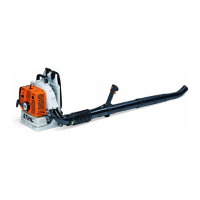4
English / USA
BR 340, BR 340 L, BR 420, BR 420 C
: Wear gloves and keep your hands
warm.
: Keep the AV system well
maintained. A blower with loose
components or with damaged or
worn AV buffers will tend to have
higher vibration levels.
: Maintain a firm grip at all times, but
do not squeeze the handles with
constant, excessive pressures, take
frequent breaks.
All the above mentioned precautions do
not guarantee that you will not sustain
whitefinger disease or carpal tunnel
syndrome. Therefore continual and
regular users should monitor closely the
condition of their hands and fingers. If
any of the above symptoms appear,
seek medical advice immediately.
!Warning!
The ignition system of your unit
produces an electromagnetic field of a
very low intensity. This field may
interfere with some pacemakers. To
reduce the risk of serious or fatal injury,
persons with pacemaker should consult
their physician and the pacemaker
manufacturer before operating this tool.
Proper Clothing
!Warning!
To reduce the risk of injury, the operator
should wear proper protective apparel.
Clothing must be sturdy and snug-fitting,
but allow complete freedom of move-
ment.
!Warning!
Avoid loose-fitting jackets,
flared or cuffed pants,
scarfs, unconfined long
hair or anything that could
be drawn into the air
intake.
Wear overalls or long
pants to help protect your
legs. Do not wear shorts.
Use of gloves when
working with the blower is
recommended.
Good footing is most
important. Wear sturdy
shoes with nonslip soles.
!Warning!
To reduce the risk of injury associated
with the inhalation of dust, use a face
filter mask when using your blower in
dusty conditions.
!Warning!
Use of this product can generate dust,
mists, and fumes containing chemicals
known to cause respiratory disease,
cancer, birth defects, or other reproduc-
tive harm. If you are unfamiliar with the
risks associated with the particular dust,
mists or fumes at issue, consult your
employer, governmental agencies such
as OSHA and NIOSH and other sources
on hazardous materials. If the substance
being blown or vacuumed is a commer-
cial substance, review the material
safety data sheet for that substance and
/ or consult the material manufacturer /
supplier. The state of California and
some other authorities, for instance,
have published lists of substances
known to cause cancer, reproductive
toxicity, etc.
Control dust, mist and fumes at the
source where possible. In this regard
use good work practices and follow the
recommendations of OSHA / NIOSH
and occupational and trade associa-
tions. When the inhalation of toxic dust,
mists and fumes cannot be eliminated,
the operator and any bystanders should
always wear a respirator approved by
NIOSH / MSHA for the substance at
issue.

